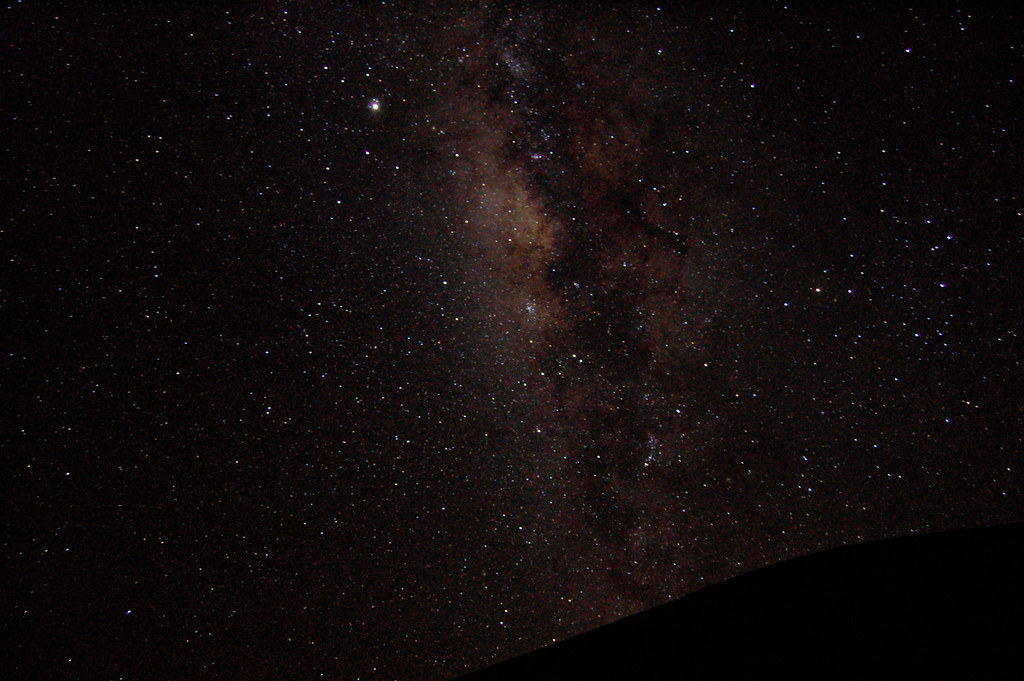Forums › Forums › Farktography General Chat › The Gallery › Improvements in astrofarktography
- This topic has 32 replies, 9 voices, and was last updated 13 years, 4 months ago by
aprillove20.
-
AuthorPosts
-
June 13, 2010 at 1:19 pm #1866
ravnostic
ParticipantThe LPR lens helps. As does the reducer. Three pictures; the Trifid Nebula, the Hourglass Nebula (both taken this morning long before dawn) and Comet McNaught 2009 (now on display at near-nekkid eye visibility). I also got multiple shots of Saturn in the evening sky and Jupiter in the morning; those, however, I need to stack before displaying. These three, other than resizing/cropping, are completely unedited in any way (I’m hoping I can make them better, of course, but that’s later.)



(Comet McNaught, btw, is up in the constellation Perseus, very shortly before dawn–hence, the lighter sky.)
June 15, 2010 at 3:23 am #29508caradoc
ParticipantJune 15, 2010 at 6:41 am #29509ravnostic
ParticipantI definitely do want to go someplace darker, and the scope is completely set up for remote locations (either batteries or a car lighter port.) My issue is about going out alone with a $3k toy (people drink, get idiotish, etc.) You’d be welcome to come along for the ride (got a 1.25″ adapter for your lens? And a gun?)
I found with the LPR lens, light pollution isn’t a problem. Somewhere in the hundreds of shot I’ve taken in the past week I have a comparison shot using the Whirlpool galaxy. A. World. of. Difference. So a little light isn’t much of an issue. But darker skies=better lighting=better night shots, definitely. My next photo opportunity will be Sunday night, then Tuesday night. Then it’s the contest, so beyond that, I’d have to wait for All Night III, or whatever.
Meteor shots are ridiculously difficult to capture; too small, too fleeting, rarely bright enough. And through a scope, it’s about impossible (though a satellite shows up as a streak every once and a while.)
June 15, 2010 at 7:10 am #29510soosh
ParticipantI’ve gotten lucky with meteors a few times



one night I was out and I saw one that was just fantastic, it absolutely looked like a huge wide sword in the sky, bright as hell for just a fraction of a second. one of the coolest things I’ve ever seen. of course, the camera was pointed in a completely different direction.
June 15, 2010 at 8:51 am #29511ravnostic
ParticipantSoosh, I envy your Alaskan skies; seriously. The November Leonid meteors are probably your best bet to better your already good shots (17th ish). While fewer in number, they can be brilliant, and given the time exposure, ‘brilliance’ is needed to make them stand out against the stars.
It’s too bad you can’t get the August Perseids (I don’t think) due to the light; they are, usually, the best show, ‘by the numbers’ (ahem). But the Leonids have very bright ones, and many leave a vapor trail in the air as well.
The best I’ve ever seen, from the Orionid showers (no relation to ours, and certainly not in a drain-baby way), was from the Phantom Ranch in the Grand Canyon when I was 11. Left a nice trail visible for several minutes (also no relation to ours, and certainly not in a drain baby way). Next best was just after my battery died in my camera, from the bar where I hang out (I was there shooting the patio); it left a trail, too, must have been outstanding from an area darker than Phoenix, but missed either way due to dead battery. It was only 8ish pm, and due to no known meteor shower that I’m aware of. But sometimes these things happen.
Captured on film: 0.
But one day, perhaps.
It must be nice having glacial mountains to use as a backdrop!
How long are your exposures? There’s very little star movement in them. For that kind of starfield, I have to expose for at least a minute at 800 ISO, and by then, stars are just streaks in the sky (unless I piggy back on my scope, of course, then I can go much longer.)
June 15, 2010 at 12:43 pm #29512 orionidParticipant
orionidParticipantActually, the orionid shower is where I get my name from. Long story.
I’ve also been toying with some ideas for this years persieds and think I have a good plan of attack come August.
I want to get back down to my parents farm and play around a bit with the new (to me) vintage newtonian and polar mount. I have too many interests and hobbies, and they all cost monies.
June 15, 2010 at 12:49 pm #29513 orionidParticipant
orionidParticipantOh, and FWIW, the BEST skies are at Mauna Kea. No, really, that’s why all the big scopes are there.

This was before I knew about things like white balance, ISO control, etc. on an 18mm f/3.5 kit lens. June 15, 2010 at 12:59 pm #29514
June 15, 2010 at 12:59 pm #29514ravnostic
ParticipantI’ve also been toying with some ideas for this years persieds and think I have a good plan of attack come August.
Every year when the Persieds are here, we’re stuck with monsoons. But should I luck out, I’ll be trying it out in the desert, if I can find a spot where I can trust I won’t get shot for some punk who wants to hock my scope for a hit of crystal meth. The scope makes a nice piggyback mount for long-exposure star fields through a more reasonable sized lens.
June 15, 2010 at 1:33 pm #29515soosh
Participantthose were 30 seconds at ISO 3200 using a 20mm lens open to f/1.8
we have crazy dark skies in the winter, and suitably dark even in August. Main problem here is 300+ days a year when it’s overcast.
June 15, 2010 at 3:30 pm #29516caradoc
ParticipantI’ll be trying it out in the desert, if I can find a spot where I can trust I won’t get shot for some punk who wants to hock my scope for a hit of crystal meth.
Actually, that’s not such a problem. I’m out there a *lot* during the storm season, and I’ve never even seen anyone who looks like they want to steal my camera or anything.
It’s a lot more common to see people who look like they’d prefer to shoot you than let you call the Border Patrol, though – the area south of I-8 near Antelope Peak used to be one of my favorite areas to chase storms.
Now? Not so much.
I will admit that 7.62x39mm and .38+p are two of my favorite friends to take with me, though.
June 15, 2010 at 9:22 pm #29517ravnostic
ParticipantI will admit that 7.62x39mm and .38+p are two of my favorite friends to take with me, though.
Say the word, and if you’ll bring your two friends along, I’m there. I’ll be bidding for OT for July this week, my ‘natural’ nights off are Sunday through Tuesday, and every other Saturday. I’ll leave something open if you say so.
June 16, 2010 at 12:36 pm #29518staplermofo
Participant*removes caradoc from “to mug” list*
June 16, 2010 at 2:39 pm #29519ravnostic
Participantorionid; GREAT shot of the Milky Way core! M7 really stands out; I’d imagine that’s Jupiter riding above Sagittarius? If so, then it was taken first half of September, 2008? (acutally, betting on August 29th 2008).
What I wouldn’t give for dark skies and 300mb of air pressure pushing down on me.
June 16, 2010 at 3:57 pm #29520caradoc
ParticipantPick a Saturday night, and we’ll go. We should have reasonably clear weather for the next three weeks or so. I’m thinking a bit east of Tortilla Flat. Not much out there – not even drug mules.
June 16, 2010 at 4:11 pm #29521ravnostic
ParticipantPick a Saturday night, and we’ll go. We should have reasonably clear weather for the next three weeks or so. I’m thinking a bit east of Tortilla Flat. Not much out there – not even drug mules.
I can do the 26th of this month or the 10th of July. Either or. Won’t be quite as dark as Hawaii, but for proximity purposes–it’ll do (esp. for the north and eastern skies; and maybe southern.)
6/26 better for McNaught, though depending on the nountain view, it may not be up before twilight breaks.
-
AuthorPosts
- The topic ‘Improvements in astrofarktography’ is closed to new replies.
